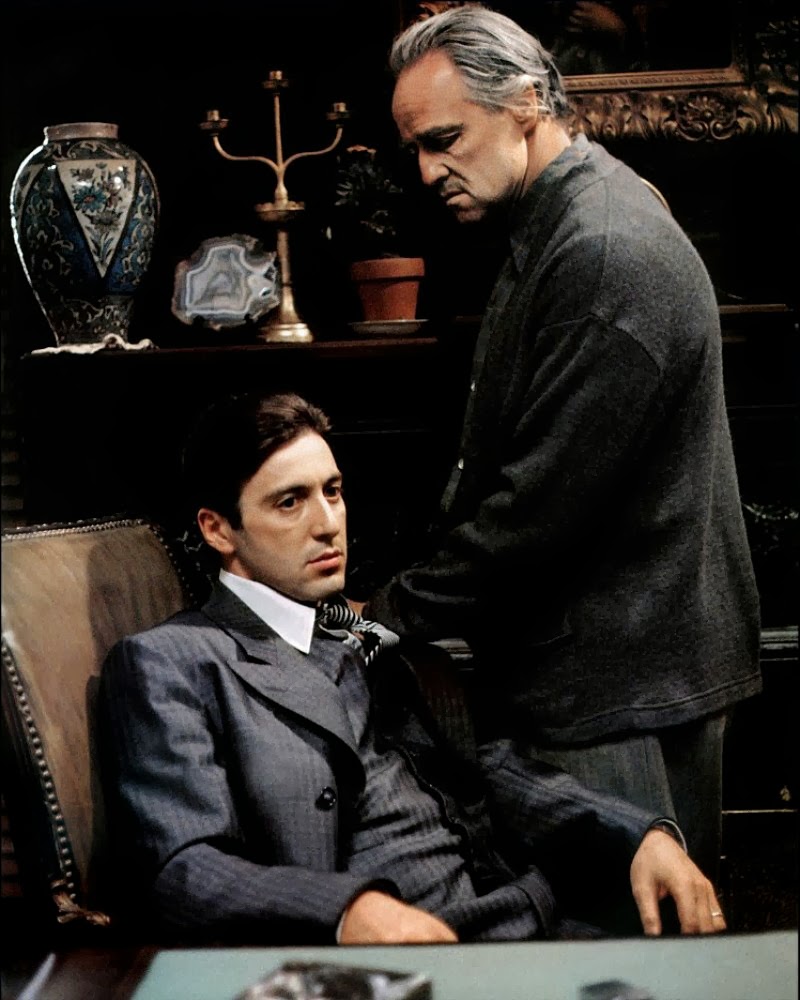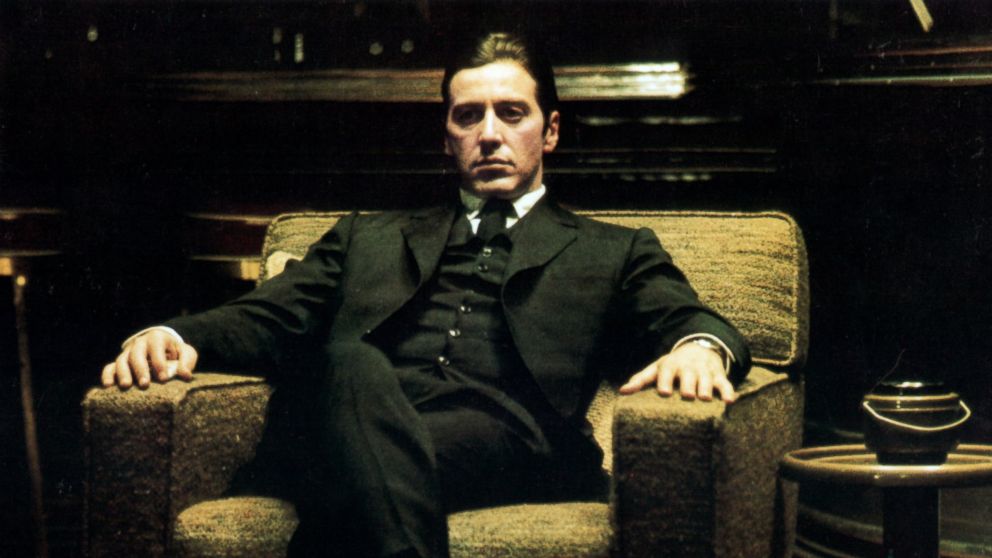The Godfather (1972)

DIRECTOR: Francis Ford Coppola
CAST: Marlon Brando, Al Pacino, James Caan, Robert Duvall, Diane Keaton, Talia Shire, John Cazale
REVIEW:
Has any other motion picture defined a genre the way The Godfather did for the gangster film? Since its release in 1972 (receiving ten Oscar nominations and winning Best Picture), it has represented the gold standard to which all other mob movies are held. Yet The Godfather, adapted by Francis Ford Coppola from the novel by Mario Puzo (who also wrote the screenplay), is no mere gangland shoot-em-up (in fact, violence comes in short, jarring bursts, few and far between). What really grants the film its distinction is the core themes of family, an underlying character arc that ultimately resembles a Shakespearean tragedy, the careful technical accomplishment of the entire production, and the richness of Puzo’s script carefully weaving myriad subplots into a cohesive whole. Non-fans of the gangster movie genre might not be enthralled, and the nearly three hour runtime and slow burn pace represents a sizable commitment of time and attention, but for mob movie aficionados, this is as good as it gets, and skillful cinematic craftsmanship by any objective standard.
We open in 1946 New York City during a festive wedding celebration at the stronghold of the Corleone family, one of the most powerful Mafia families in New York. On a wedding day, per Sicilian custom, no request can be refused, so the titular “Godfather” and aging Corleone patriarch Don Vito (Marlon Brando) is receiving a list of visitors coming to him for help with settling problems large and small, from immigration help to arranging marriages to avenging a wronged family member. Vito presides over four children, the hotheaded Sonny (James Caan), who is heir apparent but whose quick temper causes problems, weakling Fredo (John Cazale), newlywed Connie (Talia Shire), and the somewhat estranged Michael (Al Pacino), returned from WWII a war hero with a WASP-ish girlfriend Kay Adams (Diane Keaton) and wanting no part of the family business, along with the family’s adopted son and consigliere (the Don’s chief adviser) Tom Hagen (Robert Duvall). But events will conspire to draw Michael in, especially when his father spurns a potential business ally, Sollozzo (Al Lettieri), who responds with an assassination attempt. And this is merely the first spark of a war that will continue for years, cost many lives, and change the course of Michael Corleone’s life forever.
The real strength of The Godfather comes from the richness and intricate detail with which it immerses itself in its world. It’s hard to dispute that there’s some romanticizing here—Puzo and Coppola consciously play on and tap into the fascination audiences have for the mysticism surrounding gangsters, particularly of the old-school New York Italian variety—but there are no cartoon characters to be found here. Don Vito is a thoroughly old-school Mafioso who prefers to avoid violence and does not mix business with family matters. His strict adherence to values like family (“any man who doesn’t spend time with his family can never be a real man”), loyalty, and respect is viewed by some as antiquated, particularly when he rejects a lucrative offer to form a business alliance with powerful drug supplier Sollozzo, a deal even his eldest son Sonny and consigliere Tom support, believing narcotics is a “dirty business” that will cost the Corleones their political and police protection, even as some see Vito’s old-fashioned values as holding the Corleone family back from embracing the future. The most substantive character arc, however, belongs to Michael Corleone, who undergoes a near-Shakespearean tragedy of evolving (or devolving) from an innocent bystander to showing an aptitude for the family business he initially wants no part of but sacrificing his soul along the way. By the end, Michael has wiped out the Corleone family’s enemies and cemented its power, but along the way he has become colder and more ruthless than his father ever was.
The Godfather contains any number of moments that have gone down as iconic in cinema, starting right off from the prologue, with the opening strains of Nino Rota’s mournful score and a close-up headshot of the undertaker Bonasera (Salvatore Corsitto), delivering the opening lines of the movie (“I believe in America”) to start his opening monologue explaining his woes and imploring Don Vito for help. And the narrative doesn’t follow a conventional trajectory either. Al Lettieri’s Sollozzo serves as the antagonist for the first act, but there’s no real singular main “villain”, and The Godfather is no action-packed shoot-em-up; violence is few and far between, but that and its frank presentation adds to the jarring effect when it does come, in moments like a scene of domestic violence, filmed with almost Scorsese-like bluntness, Sonny’s brutal beatdown of his sister’s abusive husband Carlo (Gianni Russo), and the suspense of moments like Luca Brasi’s fate, the assassination attempt on Don Vito, the restaurant shooting, and a character blundering into an ambush. Even when one knows how they play out, the slow burn tension in these moments still has the power to get viewers glued to the screen. And the tit-for-tat gang warfare all leads up to the climactic massacre, brilliantly intercut with a baptism, followed up with an ending shot as iconic as the opening. And who can forget about the horse?
While it’s ultimately Michael’s arc that emerges as the central story thread, The Godfather weaves myriad seemingly disparate subplots, a tricky balancing act that Puzo and Coppola pull off to perfection or very nearly so, overlaid with themes like family, fathers and sons, loyalty, and the corrupting influence of power. The film is a triumph of cinematic craftsmanship; from Gordon Willis’ atmospheric muted hues to Nino Rota’s mournful score—the opening strains are instantly recognizable and iconic—every frame is carefully constructed. Every significant character—and more than a few bit side parts—emerge as distinct individuals. Everyone remembers characters like Luca Brasi (Lenny Montana, a real-life ex-bodyguard for the Colombo crime family), Clemenza (Richard S. Castellano), Tessio (Abe Vigoda), and Al Neri (Richard Bright). Even figures like the singer Johnny Fontaine (Al Martino), crooked cop Captain McCluskey (Sterling Hayden), and Hollywood producer Jack Woltz (John Marley) are distinct and memorable despite only appearing in one or two scenes. Incidentally, while the main characters and story onhand are fictional, Puzo did turn to some real-life gangland figures for inspiration; Vegas mogul Moe Green (Alex Rocco) is modeled after Bugsy Siegel, and depending on who you ask, Johnny Fontaine either is or isn’t a thinly-veiled stand-in for Frank Sinatra (Sinatra himself certainly thought so and wasn’t happy about it, although Puzo has claimed that any similarity is coincidental), helping lend to the overall sense of authenticity and verisimilitude.

A strong cast ensures the immersion is not dispelled; among the large cast of characters both large and small, there’s not a conspicuous casting/acting misstep to be found. With his jowly cheeks, deliberate mannerisms, husky whisper, and lines like “I’m gonna make him an offer he can’t refuse”, Marlon Brando’s titular Godfather is undoubtedly one of the most iconic and oft-imitated characters in movie history (in fact, Brando himself parodied his performance as Vito Corleone in the 1990 crime comedy The Freshman). Despite Brando receiving top-billing, however, the character who eventually emerges as the central protagonist and gets the most screentime is Michael, played by Al Pacino (making it all the more ill-fitting that Pacino’s Oscar nomination was for Best Supporting Actor), who with his fresh face and smooth voice barely seems like the same gaunt, haggard, smoky-voiced actor with a propensity for scenery-devouring we know from such films as Scarface, Sea of Love, Scent of a Woman, And Justice For All, The Devil’s Advocate, Carlito’s Way, Heat, etc. This isn’t one of Pacino’s more demonstrative performances—in fact, he is exceptionally low-key and subdued—but he capably navigates Michael’s character arc from a clean-cut returning war hero who wants nothing to do with the family business, to a new Don who is more ruthless than the old one (a development that dismays Vito, who had imagined Michael being the one of his children who would do something different with himself). In supporting roles are the hot and cold contrasts of James Caan’s hot-blooded, swaggering, volatile Sonny, and Robert Duvall’s stoic, all-business Tom. Diane Keaton’s WASP-ish Kay in some ways serves as an audience surrogate, a non-Italian outsider who goes in not knowing what she’s getting into.
The Godfather is a triumph of superlative cinematic craftsmanship, as superlative an example as can be found of every aspect—direction, writing, acting, cinematography, editing, musical score, narrative, thematic content—being at the top of its game and serving to amplify and compliment the overall production. The film can be enjoyed equally by those who simply appreciate an involving gangland drama, or by those who appreciate the deeper, richer themes of family and corruption. And The Godfather Part II, far from a superfluous sequel, would only further deepen and enrichen the themes set in motion here.
* * * *